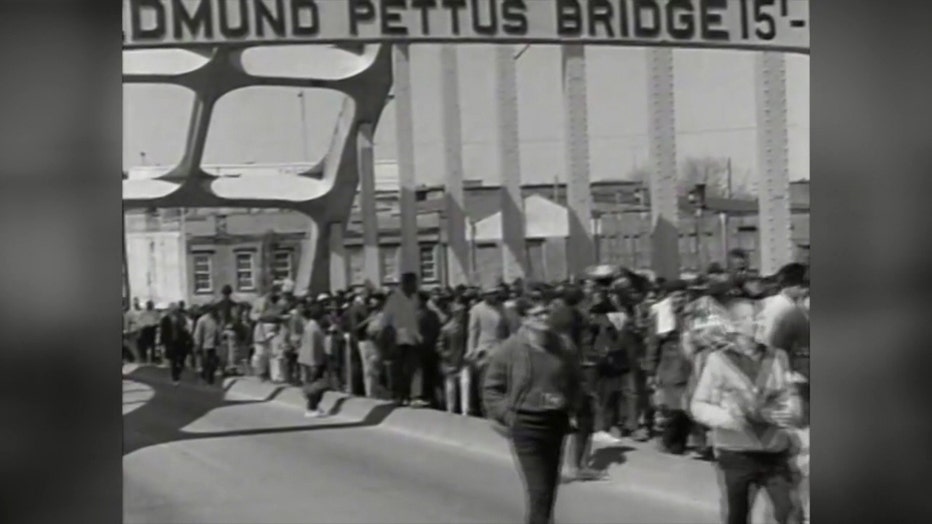America’s Path to Equality: The March for Voting Rights

America’s Path to Equality: The March for Voting Rights
FOX 13 Chief Political Investigator Craig Patrick dives into America's civil rights leaders completing their 54-mile march from Selma, Alabama, to the state capitol in Montgomery. This followed the horrific beating in Selma, commonly known as "Bloody Sunday."
SELMA, Ala. - March 25, 1965, marked a turning point in history. America's civil rights leaders completed their 54-mile march from Selma, Alabama to the state capitol in Montgomery 60 years ago.
It inspired the Voting Rights Act and changed the course of history. It also followed the horrific beating in Selma commonly known as "Bloody Sunday."
RELATED: America’s Path to Equality: Bloody Sunday
The backstory:
On March 7th, 1965, African Americans peacefully marched for the right to vote and were beaten near Selma’s Edmund Pettus Bridge by the forces of segregationist Governor George Wallace.
"It is difficult to talk about without getting a little emotional because I had never seen that much hatred. I had never seen anything like that before in all my life," said Jeff Drew, a student activist from Birmingham who joined the Selma movement.
For background, the federal government gave blacks the right to vote after the civil war. Then, after Reconstruction, southern states effectively took it away through intimidation, poll taxes and difficult tests called poll exams or literacy tests.
"On occasion, they were asked to count the number of bubbles on a bar of soap, the number of jellybeans in a jar," said former Congressman John Lewis, before dying in 2020.
Two days after Bloody Sunday, Dr. Martin Luther King, Jr. led a second march and suspended it when he saw armed troopers blocking their path. That night, a mob found and murdered James Reeb, a white minister who had joined the march.
Dr. King sought and received help from federal court. A judge ordered state troopers to stand aside for the march to resume. Meanwhile, President Lyndon B. Johnson federalized the national guard to protect the marchers.
It took bi-partisan support from a Democratic U.S. president and a Republican judge to proceed.
PREVIOUS: America’s Path to Equality: Selma and the Tampa Connection
"I always point out to my Republican friends that all the people who decided in our favor were Republicans," said Dr. King’s right-hand man, Andrew Young. "Every case we won across the south, it was a Republican judge."

Dig deeper:
Al Lingo had marched through Florida, and was in this St. Augustine pool with black friends, when the motel owner attacked them with acid. His parents wanted him to stop, but he and thousands of others are drawn to Selma after Bloody Sunday, because it is dangerous and needs to change.
"There were young people who were making something go, and kind of defeating the notion that everything is really okay here," said Lingo.
White supremacists arrived as spectators along the curb. Some spit at marchers and journalists as they passed.
Jeff Drew was one of the march runners around the Edmund Pettus Bridge — meaning he ran along the edge of the road.
READ: America’s Path to Equality: The Selma Movement
"My job and other kids my age. We were commissioned to run from the back of the bridge all the way to the front and back to keep the marchers from accidentally stepping on the curb," he said.
Andrew Young managed the pace, and Former Florida Governor LeRoy Collins helped him keep people safe. As governor, Collins denounced segregation, killed his career in state politics, and found a higher calling in the cause of civil rights.
A parade of nuns, ministers and students swelled to more than 30,000 people. They walked through cold rain and stopped at farms that invited them to eat and sleep.
"We lived in tents," said Richard Smiley, a march participant and retired Tampa professor. "On the road they had farmers. Some of the farmers would let us put up a tent."
Newsreels depicted them as foot soldiers for freedom, while segregationist propaganda claimed they were communists. It's a narrative of triumph, versus fear tactics that worked back then throughout much of the south. That’s why peaceful marchers call it the "Battle of Selma."
"The real struggle is a struggle for what’s true," Lingo said.
Tampa's Path to Equality:
- Part 1: The First Steps
- Part 2: The Awakening
- Part 3: 'Election of the Century'
- Part 4: The Sit-ins
- Part 5: The Breakthrough
- Part 6: The 'Tampa Technique'
- Part 7: Live on Stage
They knew they could prevail the farther they marched and the harder they pushed.
"There was a white guy named Jim. He had one leg and was on crutches. I knew him personally. He walked that whole 50 miles," said Smiley. "When he got to Montgomery, he had calluses as big as my hand."
The march inspired Congress to pass the Voting Rights Act, which President Johnson signed on August 6, 1965. It banned the difficult tests and other tactics that disenfranchised black voters for generations. It empowered voter registration drives, expanded the electorate, produced a new generation of African American leaders, and it serves as one of our greatest strides on America's Path to Equality.
The Source: The information in this story was gathered through research and interviews conducted by Craig Patrick.
WATCH FOX 13 NEWS:
STAY CONNECTED WITH FOX 13 TAMPA:
- Download the FOX Local app for your smart TV
- Download FOX Local mobile app: Apple | Android
- Download the FOX 13 News app for breaking news alerts, latest headlines
- Download the SkyTower Radar app
- Sign up for FOX 13’s daily newsletter

